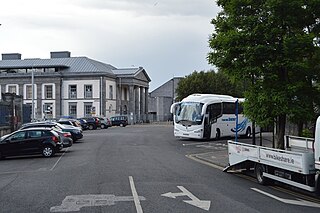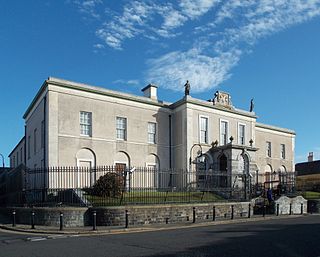
Craigavon is a town in northern County Armagh, Northern Ireland. Its construction began in 1965 and it was named after the first Prime Minister of Northern Ireland: James Craig, 1st Viscount Craigavon. It was intended to be the heart of a new linear city incorporating Lurgan and Portadown, but this plan was mostly abandoned and later described as having been flawed. Among local people today, "Craigavon" refers to the area between the two towns. It is built beside a pair of artificial lakes and is made up of a large residential area (Brownlow), a second smaller one (Mandeville), plus a central area (Highfield) that includes a substantial shopping centre, a courthouse and the district council headquarters. The area around the lakes is a public park and wildlife haven made up of woodland with walking trails. There is also a watersports centre, golf course and ski slope in the area. In most of Craigavon, motor vehicles are completely separated from pedestrians, and roundabouts are used extensively. It hosted the headquarters of the former Craigavon Borough Council.

The Royal Courts of Justice in Chichester Street, Belfast is the home of the Court of Judicature of Northern Ireland established under the Judicature Act 1978. This comprises the Northern Ireland Court of Appeal, High Court of Northern Ireland and the Crown Court in Northern Ireland. It is a Grade A listed building.

The Crumlin Road Courthouse is a former judicial facility on Crumlin Road in Belfast, Northern Ireland. It is a Grade B+ listed building.

Lisburn Courthouse is a judicial facility in Railway Street in Lisburn, County Antrim, Northern Ireland. It is home to the magistrate's and county courts.

Portlaoise Courthouse is a judicial facility in Portlaoise, County Laois, Ireland.

Longford Courthouse is a judicial facility in Main Street, Longford, County Longford, Ireland.

Mullingar Courthouse is a judicial facility in Mullingar, County Westmeath, Ireland.

Wicklow Courthouse is a judicial facility in Wicklow, County Wicklow, Ireland.

Limerick Courthouse is a judicial facility at Merchant's Quay, Limerick, County Limerick, Ireland.

Downpatrick Courthouse is a judicial facility on English Street, Downpatrick, County Down, Northern Ireland. The courthouse, which served as the headquarters of Down County Council from 1878 to 1973, is a Grade B+ listed building.

Enniskillen Courthouse is a judicial facility in East Bridge Street, Enniskillen, County Fermanagh, Northern Ireland. It is a Grade B listed building.

The Bishop Street Courthouse is a judicial facility in Bishop Street, Derry, County Londonderry, Northern Ireland. It is a Grade A listed building.

Omagh Courthouse is a judicial facility in High Street, Omagh, County Tyrone, Northern Ireland. It is a Grade B+ listed building.

The Old Courthouse is a former judicial facility on Castlerock Road in Coleraine, County Londonderry, Northern Ireland. It is a Grade B1 listed building.

County Hall is a municipal facility at Galgorm Road in Ballymena, County Antrim, Northern Ireland. It served as the headquarters of Antrim County Council from 1970 to 1973.

County Hall is a municipal facility in Coleraine, County Londonderry, Northern Ireland. It served as the headquarters of Londonderry County Council from 1960 to 1973.

County Hall is a municipal facility in Drumragh Avenue, Omagh, County Tyrone, Northern Ireland. It served as the headquarters of Tyrone County Council from 1962 to 1973.

County Buildings is a municipal facility in East Bridge Street, Enniskillen, County Fermanagh, Northern Ireland. It served as the headquarters of Fermanagh County Council from 1960 to 1973.

Charlemont Place is a row of terraced houses in Armagh, County Armagh, Northern Ireland. The buildings served as the headquarters of Armagh County Council from 1945 to 1973. They are all Grade A listed buildings.

Lurgan Town Hall is a municipal structure in Union Street, Lurgan, County Armagh, Northern Ireland. The structure, which is primarily used as a community, arts and resource centre, is a Grade B1 listed building.






















